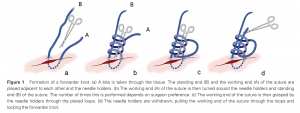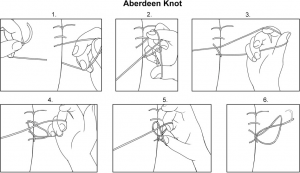General Surgery
Knots – Forwarder and Aberdeen
Forwarder knots
Forwarder knots are more secure than square knots for the start of continuous runs and function well in fat and fluid media. However, they are challenging to perform.

- Take a bit through the tissue from left to right
- Hold the working end of the suture in the left hand; needle holder and free end of the suture in the right hand.
- Turn the working end around both the needle holder and the free end of the suture. Repeat twice more, creating three throws about the combination.
- Grasp the working end with the needle holders, pulling the working end through the looped throws as the needle holder is withdrawn
- Pull the working end and free end in opposite directions, tightening and locking the knot

Aberdeen knots
Aberdeen knots are used at the end of a continuous run. They result in better security with less bulk than square knots, particularly in continuous runs.

- Take the final bite of the continuous pattern through the tissue from right to left, leaving a large loop
- Hold the working end of the suture (needle attached) in the left hand
- Create a second loop in the working end and pass it through the first loop, while maintaining tension. This equals one throw
- Repeat for 4 throws
- Pull the working end through the final loop and tighten to lock the knot
They are also an easier way to bury your knot.
Resources
McGlinchey L et al. Bursting strength of surgeon’s and self-locking knots for closure of ventral midline celiotomy in horses. Vet Surg 2018, 47(8):1080-1086
Gillen AM et al. In Vitro Evaluation of the Size, Knot Holding Capacity, and Knot Security of the Forwarder Knot Compared to Square and Surgeon’s Knots Using Large Gauge Suture. Vet Surg 2016, 45:1034-1040

